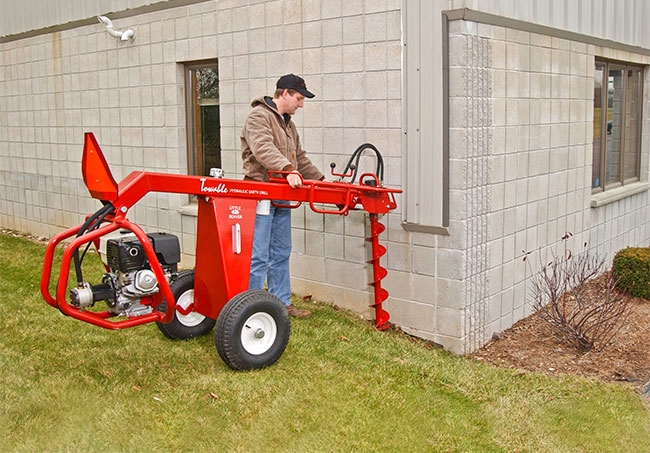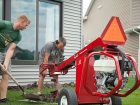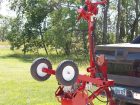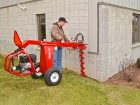
News
Landscaping
Turf Care Equipment
Equipment addresses an aging workforce
With age comes a greater propensity for worksite injuries.
December 12, 2018 By Mike Hale
 The towable drill features a handle users can rotate 180-degrees for safe operation near buildings and in hard-to-reach areas.
The towable drill features a handle users can rotate 180-degrees for safe operation near buildings and in hard-to-reach areas. Lifting and handling 100 pounds can be a difficult task, even for young and fit individuals. For many workers, it’s a quick ticket to the emergency room – followed by a costly workers’ compensation claim for their employer.
Sprains, strains and tears are the leading injuries among all jobs, according to the U.S. Bureau of Labor Statistics. Most require an employee to take time away from work to recover, sometimes as long as 10 days.
Meanwhile, the proportion of U.S. workers 55 or older increased to 39.4 per cent in 2008 from 31.3 per cent in 1998 and is expected to reach 43.5 per cent this year. (Statistics are proportionally similar in Canada). Studies show that with age comes greater propensity for worksite injuries. This combination of injuries and aging is driving more companies to turn to their equipment for solutions.
When it comes to fence and deck building, landscaping and sign installation, the earth drill market has evolved to accommodate. A unique class of drills – towable and hitch-mounted – lessens the toll on operators and provides a solution for the challenges of an aging workforce. The design of these compact and lightweight machines deliver safety, ease of use and the manoeuvrability to go virtually anywhere, as well as the productivity and power of a skid steer auger attachment.
Equipment manoeuvrability
In general, the easier equipment is to move, the easier it is to use. Whether used by homeowners or contractors, mobility is key to earth drill productivity. Towable and hitch-mounted drills excel in their ability to be transported to and from, and also manoeuvred around jobsites with ease.
With either a hitch for towing or a hitch mount bracket that acts as a drill carrier, these drills’ transport systems require very little operator effort and eliminate the need to lift the drill on and off of a trailer or into the back of a pickup.
Manoeuvrability doesn’t end at the curb, however. Once on site, it’s important to have a drill that’s easy to move from hole to hole, wheel around the site and navigate through narrow spaces, such as between gates and buildings. Most towable and hitch-mounted rigs feature either pneumatic or semi-pneumatic tires to easily push around site and glide across the ground without damaging turf.
Operator-focused design
Beyond portability, towable and hitch-mounted drills are often designed so their frame bears the brunt of the operating weight, not the operator. Many feature a “teeter-totter” design that allows the weight of the auger to be offset by the engine, lessening the impact on the operator during operation.
With wheels incorporated near the centre of the machine and optimal balance, operators can easily pivot the drill into place and reduce the physical push down force on the drill. This design can reduce operating weight by as much as 50 per cent over traditional earth drills and requires as little as 20 pounds of force to pivot the drill.
While ease of operation is key for reducing worksite injuries, it shouldn’t come at the expense of power. Drills need to operate with high torque to maximize productivity, but if that torque transfers to the operator, it can take a significant toll on his body. The frames of towable and hitch-mounted drills absorb drilling torque, keeping the operator in complete control of the drill without worrying about kickback.
Operator-friendly design features also come into play should an auger get caught under tree roots or hit large objects such as rocks. Having reverse rotation goes a long way toward easy and safe operation. The feature allows the operator to simply reverse the auger if it becomes stuck, as opposed to manually turning and lifting the auger from the hole. For added safety, some drills feature pressure relief valves to stop the auger if the drill reaches a certain hydraulic pressure.
Convenience
Operators often work near buildings and in hard-to-reach areas, which is why it’s important for drills to feature a two-position handle. This allows operators to position the handle in a manner that prevents it from getting between the drill and the structure, allowing for safe work near buildings and walls.
For even greater productivity and safety, drills featuring a variable auger tilt will allow for vertical drilling in uneven terrain, such as on hills with varying slopes. This greatly reduces strain as well as the strength needed to control the drill. By having the drill tilt to offset the slope, the operator can remain level and simply adjust the auger to the desired position.
Snap-on augers and adaptors also lessen the operator’s effort when drilling and come in a variety of sizes, compatible with nearly any drill. This makes it easy for one operator to quickly switch augers on the jobsite as drilling conditions change. This requires less physical effort while saving time and increasing ROI, so contractors can quickly move on to the next job.
Drilling down to the point
It’s no secret that it’s hard to find people willing to do manual labour. The wear and tear on one’s body along with jobsite risks and injury are just a few of the reasons the younger workforce prefers other work. As the existing workforce continues to age, more equipment options are necessary to provide the ideal solution for each business’ unique workforce challenges. Towable and hitch-mounted drills are just one way to maintain productivity with an aging or inexperienced workforce.
Mike Hale started his career in the fence industry in 1974. In 1996 he began working at Little Beaver Inc., a leading manufacturer of portable earth drills and accessories. As the sales manager, he offers expertise on fencing and hole digging equipment. Questions or comments can be directed to him at mikeh@littlebeaver.com or (800) 227-7515.
Little Beaver serves the needs of end-users from professional contractors to rental centres. For more information, call (800) 227-7515, email sales@littlebeaver.com or visit www.littlebeaver.com.
Print this page


